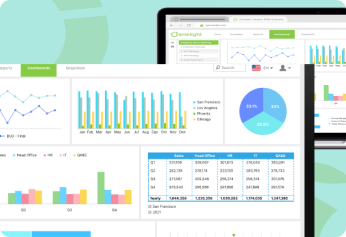Operating Cash Flow (OCF) represents the cash generated from a company's core business operations during a specific period. Unlike accounting profits that include non-cash items, OCF shows the actual cash flowing in and out of your business from day-to-day activities.
Think of OCF as your company's financial pulse. It measures how well your business converts sales into actual cash, excluding financing activities like loans or investments in equipment. For finance teams managing budgets and forecasts, OCF provides the clearest picture of operational health.
OCF includes cash from customer payments, supplier payments, employee wages, rent, and other operational expenses. It excludes capital expenditures, loan payments, or money raised from investors – those fall under investing and financing activities.
Importance of Operating Cash Flow
OCF serves as a critical indicator of your company's ability to sustain operations without external funding. Here's why it matters:
- Liquidity Assessment: OCF shows whether your business generates enough cash to pay bills, employees, and suppliers without borrowing money. A restaurant chain, for example, needs consistent OCF to cover daily expenses like food costs and staff wages.
- Operational Efficiency: Strong OCF indicates your business model works effectively. If you're selling products but OCF remains negative, it signals collection problems or unsustainable pricing.
- Investment Decisions: Positive OCF provides funds for growth opportunities without requiring external financing. Companies with strong OCF can invest in new equipment, expand locations, or increase inventory during peak seasons.
- Creditworthiness: Lenders examine OCF to assess loan repayment ability. Banks prefer lending to businesses with consistent positive cash flow from operations.
- Dividend Sustainability: Public companies need strong OCF to maintain dividend payments to shareholders without compromising operations.
How to Calculate Operating Cash Flow
OCF calculation follows two primary methods: the direct method and the indirect method. Most businesses use the indirect method because it's easier to prepare from existing financial statements.
Operating Cash Flow Formula
1. Indirect Method Formula:
Operating Cash Flow = Net Income + Non-cash Expenses + Changes in Working Capital
2. Direct Method Formula:
Operating Cash Flow = Cash Receipts from Operations - Cash Payments for Operations
The indirect method starts with net income and adjusts for non-cash items and working capital changes. Non-cash expenses include depreciation, amortization, and stock-based compensation. Working capital changes involve accounts receivable, inventory, and accounts payable fluctuations.
Example of Operating Cash Flow Calculation
Let's walk through a practical example using the indirect method:
ABC Manufacturing Company - Year 2024:
|
Item
|
Amount
|
|
Net Income
|
$150,000
|
|
Depreciation Expense
|
$25,000
|
|
Increase in Accounts Receivable
|
($30,000)
|
|
Increase in Inventory
|
($20,000)
|
|
Increase in Accounts Payable
|
$15,000
|
Step 1: Start with Net Income: $150,000
Step 2: Add back non-cash expenses: $150,000 + $25,000 = $175,000
Step 3: Adjust for working capital changes:
- Accounts Receivable increase reduces cash: -$30,000
- Inventory increase reduces cash: -$20,000
- Accounts Payable increase adds cash: +$15,000
Step 4: Calculate final OCF: $175,000 - $30,000 - $20,000 + $15,000 = $140,000
This means ABC Manufacturing generated $140,000 in operating cash flow, indicating healthy operations despite investing more in receivables and inventory.
Operating Cash Flow vs. Net Income
Understanding the difference between OCF and net income helps you make better financial decisions:
|
Aspect
|
Operating Cash Flow
|
Net Income
|
|
Timing
|
Records actual cash movements
|
Records transactions when they occur
|
|
Non-cash Items
|
Excludes depreciation, amortization
|
Includes all accounting adjustments
|
|
Working Capital
|
Reflects changes in receivables, inventory, payables
|
Doesn't show cash timing differences
|
|
Use Case
|
Shows liquidity and cash generation
|
Shows profitability and accounting performance
|
Real-world Example: A software company might report $100,000 net income but have negative OCF if customers pay slowly or the company prepaid annual expenses. Conversely, a business might show low net income due to high depreciation but generate strong positive OCF.
Net income follows accounting principles that match revenues with expenses, regardless of cash timing. OCF shows when money actually moves, making it more relevant for daily operations and cash management.
Operating Cash Flow vs. Free Cash Flow
Both metrics measure cash generation, but they serve different purposes:
Operating Cash Flow measures cash from core business activities only. It answers: "How much cash does our business generate from operations?"
Free Cash Flow goes further by subtracting capital expenditures needed to maintain and grow the business. The formula is:
Free Cash Flow = Operating Cash Flow - Capital Expenditures
|
Metric
|
What It Measures
|
Best Used For
|
|
OCF
|
Cash from operations only
|
Operational efficiency, short-term liquidity
|
|
FCF
|
Cash available after necessary investments
|
Long-term value, dividend capacity, debt repayment
|
A manufacturing company might have $200,000 OCF but spend $150,000 on new equipment, resulting in $50,000 FCF. The OCF shows strong operations, while FCF reveals how much cash remains for shareholders or debt reduction.
Analyzing Operating Cash Flow
Interpreting OCF requires context about your industry, business model, and growth stage. Here's how to analyze OCF effectively:
- Positive vs. Negative OCF: Consistently positive OCF indicates healthy operations. Negative OCF isn't always bad – growing companies often invest heavily in inventory and receivables, temporarily reducing cash flow.
- OCF Trends: Look at OCF patterns over multiple periods. Declining OCF despite growing sales might signal collection problems or margin pressure.
- OCF Quality: High-quality OCF comes from core operations, not one-time events. Be cautious of OCF boosted by delaying supplier payments or aggressive collection tactics.
- Industry Benchmarks: Compare your OCF margin (OCF ÷ Revenue) to industry peers. Retail businesses typically have different OCF patterns than service companies.
- Seasonal Patterns: Many businesses experience seasonal OCF fluctuations. Retailers often see negative OCF in early quarters as they build inventory for holiday seasons.
Limitations of Operating Cash Flow
While OCF provides valuable insights, it has limitations:
- Short-term Focus: OCF doesn't show long-term sustainability. A company might boost current OCF by cutting essential maintenance or research spending.
- Manipulation Potential: Management can temporarily inflate OCF by extending payment terms with suppliers or aggressively collecting receivables.
- Growth Investment: High-growth companies often show lower OCF as they invest in working capital to support expansion.
- Timing Differences: OCF fluctuates based on payment timing, which might not reflect underlying business performance.
- Capital Requirements: OCF doesn't account for necessary capital investments to maintain competitive position.
How to Improve Operating Cash Flow
Strengthening OCF requires focused attention on cash conversion and operational efficiency:
1. Revenue and Collections
Step 1: Accelerate customer payments through:
- Offering early payment discounts (2/10 net 30 terms)
- Implementing automated invoicing systems
- Following up on overdue accounts promptly
- Requiring deposits for large orders
Step 2: Optimize pricing strategies:
- Review pricing annually to maintain margins
- Eliminate unprofitable products or services
- Focus sales efforts on higher-margin offerings
2. Expense Management
Step 3: Streamline supplier payments:
- Negotiate longer payment terms without penalties
- Take advantage of early payment discounts when beneficial
- Consolidate suppliers for better terms
Step 4: Control operating expenses:
- Automate routine processes to reduce labor costs
- Renegotiate contracts for utilities, insurance, and services
- Implement energy-saving measures
3. Working Capital Optimization
Step 5: Manage inventory efficiently:
- Use just-in-time ordering for fast-moving items
- Identify and liquidate slow-moving inventory
- Improve demand forecasting accuracy
Step 6: Balance growth with cash flow:
- Monitor accounts receivable aging closely
- Set credit limits based on customer payment history
- Consider factoring receivables if cash flow is tight
Streamline Your Cash Flow Management with Limelight
Managing operating cash flow effectively requires reliable, real-time data from all your business systems. Limelight's FP&A platform helps finance teams move beyond manual spreadsheet processes to gain faster, more accurate insights into cash flow patterns.
With pre-built templates for cash flow forecasting and seamless integrations with major ERP systems, Limelight enables you to monitor OCF trends, identify improvement opportunities, and make data-driven decisions without the usual delays.
Book a demo to see how Limelight can strengthen your financial planning and cash flow management.
Frequently Asked Questions
Q: What's a good operating cash flow ratio?
A: OCF margin (OCF ÷ Revenue) varies by industry. Generally, 15-20% is considered healthy for most businesses, but service companies often achieve higher margins than manufacturing or retail businesses.
Q: Can operating cash flow be negative?
A: Yes, and it's not always concerning. Growing businesses often have negative OCF as they invest in inventory and extend credit to customers. However, persistently negative OCF without growth might signal operational problems.
Q: How often should I calculate operating cash flow?
A: Monthly OCF calculations help with cash management, while quarterly calculations align with financial reporting. Annual OCF provides the clearest picture for strategic planning.
Q: Does operating cash flow include taxes?
A: Yes, cash payments for income taxes are included in operating cash flow as they're part of normal business operations.
Q: What's the difference between EBITDA and operating cash flow?
A: EBITDA is an accounting measure that excludes interest, taxes, depreciation, and amortization. OCF is a cash measure that shows actual cash movements and includes working capital changes.



